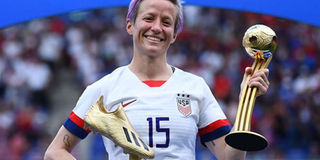Inequality in pay is affecting female athletes in big way

United States' forward Megan Rapinoe poses with the Golden Boot and Golden Ball awards after the France 2019 Women’s World Cup final match between USA and the Netherlands, on July 7, 2019, at the Lyon Stadium in Lyon.
What you need to know:
Historically, sports has and continues to be considered inappropriate for women
It almost feels foolish to comment on the subject of pay inequality because it is one that seems highly resistant to change, but this is a conversation that we must have.
For no matter how tired and worn out man gets from letting off his chest an issue that causes him great distress, the discussion must be held again and again, until the burden of anxiety lifts and a solution is found.
It is no secret that in the sports world, men are regarded as an investment while women are viewed as an expense.
So, whenever women demand for higher wages, you will hear all manner of excuses about how the women’s game is not profitable enough, or isn’t attractive enough and bla bla bla….
At a women’s sports conference I attended in Botswana four years ago, one Ghanaian participant stood and said that it was foolhardy to expect female athletes to be paid the same as their male counterparts.
“Do you understand ROI (return on investment?)” the Ghanaian, whose name was Billy Bello, posed in a desperate effort to get others to see his point of view. I didn’t get the chance to answer him but if I could, I would have told him that it isn’t that consumers value men’s sport more, in turn making the same more valuable to companies. It is that “maleness” that gives companies high ROI on men’s sport and male athletes. This is a broad issue that has been hijacked by patriarchal and societal notions.
Historically, sports has, and continues to be, considered inappropriate for women, both as an activity and an interest.
Don’t you find it strange that even female sports fans end up despising the women’s game? The only decipherable way to explain this, in my opinion, is that the men’s game is so heavily embedded in our social interactions and culture that women are forced to support teams they have no interest in, just to be “correct.”
If I follow Arsenal or Manchester City, I will have something to say at the office when my colleagues are having football banter. But let’s say I have an abiding passion for the women’s game. How many people can I discuss Megan Rapinoe’s latest endorsement deal with? Or Vihiga Queens’ dominance in the Kenya Women’s Premier League?
If a Kenyan woman wants to follow the women’s premier league, how is she going to access it? None of the games are available on TV, and the girls usually play in unsightly pitches in far flung areas where it is almost impossible to reach every weekend. And think about the self-imposed barriers, including fear for personal safety while leaving the stadium.
All this means that a woman will have more difficulty attending a match, which means the women’s game will continue to suffer low spectator numbers and less revenue because most money comes from fans watching online or on TV.
Whether consciously or unconsciously, we have produced a society of such significant inequality that the gap has refused to narrow despite numerous efforts and campaigns.
One hopes that this decade will see less myths being peddled to explain away this very important matter.
In this decade, I hope that the misogyny and sexism underlying the lack of support for female athletes will no longer prevent women from being treated the way they deserve.
Amen.





